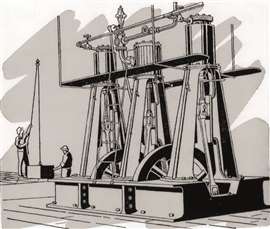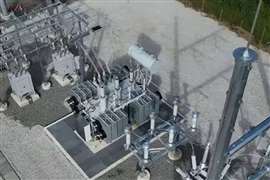Cornerstones: Compressors for refrigeration
May 01, 2025
This continues a series of Cornerstones of Compression corollary articles that provide an historical look at the industries that drove the invention and technological evolution of compressors and that supported the growth and development of the industries that depended on them. This issue continues a brief look at compressors developed for “making cold.”
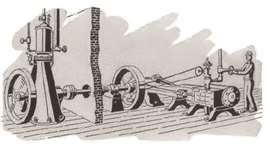 Frick ammonia cylinder refrigeration mounted on an existing vertical steam engine frame, 1882.
Frick ammonia cylinder refrigeration mounted on an existing vertical steam engine frame, 1882.
Following the early refrigeration machine success of De La Vergne and Charles Ball’s Ice and Cold Machine Co., several other companies soon entered the business of developing and manufacturing refrigeration compressors. The most prominent of those was the Frick Company, a well-established Waynesboro, Pennsylvania steam engine and agricultural machinery manufacturer that was started by George Frick in 1853.
The refrigerating department of the Frick Company originated in c.1881, when either a Mr. Jariman or a Mr. Ferguson, of Baltimore, Maryland, submitted a plan of machinery to George Frick, and plants were subsequently erected for several parties in that city. In the following year, Mr. Ferguson worked on a new design for a compressor with an ammonia cylinder to be used as a refrigeration machine, the plans for which were also shown to Mr. Frick.
In 1882 Frick entered the refrigerating machinery field by building an ammonia compressor cylinder which was mounted on the frame of an existing vertical steam engine that was driven by a direct-coupled horizontal steam engine as shown in Fig. 1. Frick constructed a few of these machines for Ferguson and then commenced to manufacture for themselves in 1883. The first complete Frick refrigerating machine, shown in Fig. 2, had two 12 in. (305 mm) bore x 16 in. (406 mm) stroke ammonia cylinders with a steam cylinder between them. It ran at 50 to 55 rpm and developed 25 tons of refrigeration. (One ton of refrigeration is the cooling effect obtained by melting one ton of ice every 24 hours.) Success of its first ammonia compressors stimulated a demand, and Frick Company in the mid-1880s developed an entire line of large refrigerating machines, driven by the Frick’s new Corliss steam engines.
At about the same time in 1882, the Weiser & Vilter Manufacturing Co. of Milwaukee, Wisconsin designed and built a horizontal, double-acting refrigerating compressor. Weiser & Vilter had been started in 1867 by Peter Weiser. Ernst Vilter joined the company in 1871 and it became a major manufacturer of steam engines by the early 1880s. Weiser recognized the advantages of a horizontal double-acting compressor at a time when nearly all machines then being built were of the single-acting vertical type. The first machine was installed in the Cream City Brewery in Milwaukee. Weisel & Vilter grew rapidly by producing steam-driven refrigeration compressors and Corliss steam engines for ice plants, dairies, breweries, and meat and fish packing industries. After Vilter’s sons purchased Weiser’s shares, the company was reorganized as the Vilter Manufacturing Company. In addition to building large machines, by c.1889, Vilter also developed a “small pattern” refrigerating machine that was driven by a slide-valve steam engine on the same bed opposite the compressor as shown in Fig. 3. These compact 80 to 100 rpm machines, which had ammonia cylinder diameters of 5 to 8 in. (127 to 203 mm) and strokes of 8 or 10 in. (203 to 254 mm), provided refrigeration to smaller enterprises.
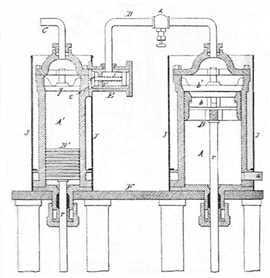 York patented St. Clair compound ammonia compressor, 1892.
York patented St. Clair compound ammonia compressor, 1892.
In 1885, W.G. Lock, an engineer from Sydney, Australia, patented a compound compressor for ammonia, consisting of two single-acting high- and low-pressure stages side-by-side. Patents covering the idea were issued as early as 1867, but the Lock technology, used with a machine manufactured by the York Manufacturing Co., were great improvements. York patented this as the St. Clair machine in 1892, shown in Fig. 4. York Manufacturing Co. had been founded in York, Pennsylvania in 1874, building its first ice machine for a customer in Mississippi in 1885. By 1897, York had sold or discontinued all other product lines, focusing entirely on ice making and refrigeration machines, later becoming a leader in HVAC equipment as well.
Although York, Frick, Vilter, De La Vergne and Ball’s Ice and Cold Machine Co. were among the earliest and most prominent manufacturers of refrigeration compressors, many other manufacturers emerged in the decade of the 1880s to fill the burgeoning demand for ice making and mechanical refrigeration in breweries, meat packers, creameries, hotels, restaurants, steam ships and many more businesses. By 1891, the periodical, Industrial Refrigeration, contained advertisements from no less than 30 U.S. manufacturers of ice making and refrigeration machines.
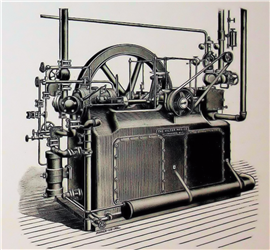 York patented St. Clair compound ammonia compressor, 1892.
York patented St. Clair compound ammonia compressor, 1892.
By the late 1890s, demand increased for smaller size refrigeration compressors, having lighter parts and running at higher speeds, for moderate capacity refrigerating systems to serve hotels, restaurants, hospitals and various industrial plants. As steam power was not always available, other types of drive were introduced. Frick’s first direct-connected electric DC motor-driven compressor was built in the early 1900s. These adaptable machines paved the way for the wide acceptance of mechanical refrigeration.
MAGAZINE
NEWSLETTER

CONNECT WITH THE TEAM






